Italy - Sicily
Between Scylla and Charybdis
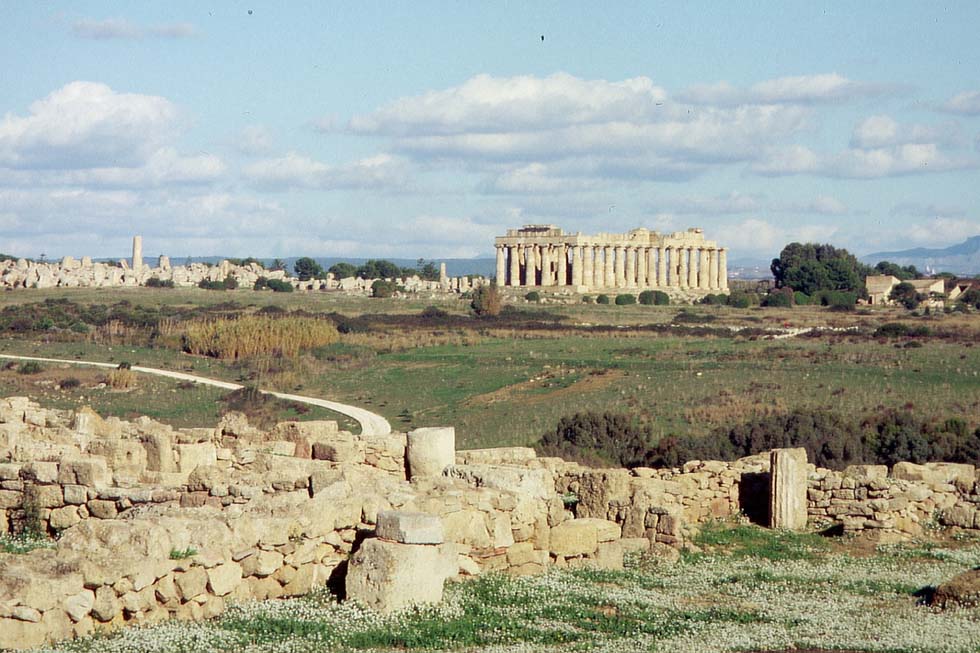
Sicily, the temple of Selinunte (WS)
These names, handed down in Homer's Odyssey, have become a familiar quotation for being exposed in great danger. Scylla, a six-headed monster, living on a dangerous rock opposite a whirlpool called Charybdis in the straits separating the Isle of Sicily from the Italian mainland, was to claim many victims on ships and their crews. In 628 B.C. the Greeks founded their most western settlement at Selinunte on the island. Since 1872 from time to time was discussed the question to cross the Strait of Messina by a bridge, at last under the government of Silvio Berlusconi, but then once again the idea vanished from the headlines.
After a varied history, Sicily and Naples have fallen into the hands of Giuseppe Garibaldi and his Red Shirts in 1860. They ended the reign of the Bourbons and made the island part of the young Kingdom of Italy. By exploitation of the natural resources during the varying foreign rules a poor and unsafe country, controlled by Mafia and menaced by malaria, had been left and no foreign enterprise was disposed to invest there.
Railway to Sicily
It was the Societa Vittorio Emanuele, which started railway building in Sicily. This company had been founded with the intention to connect France with Italy, but when Savoy was given away to France, they changed to investment in the utmost south. The harbour close to the mainland is Messina. The standard-gauge railway from Messina southward to Catania was completed in 1867, taken over in 1868 by the Calabro-Sicule. Reggio on the mainland, opposite to Messina, got a rail connection with the economic centres of Italy in 1875, first by the long way via Taranto, connecting there with the Meridionali, and only from 1880 by Calabro-Sicule to Naples. Because of the difficult conditions in Sicily, the capital Palermo was linked with Messina via Catania not before 1880 and only in 1895 by a direct coastal line. In the meantime the Pullman Palace Car Company had introduced under a contract of 1874 Pullman-type saloon sleepers in Italy, assembled in 1876 and 77 at Turin. On the Taranto - Reggio route, the car 'Castalia' (together with 'Australia' transferred from England in 1883) burnt out in 1884 (then 'Mars' was transferred). Georges Nagelmackers, the founder of the Wagons-Lits company CIWL, had negotiations with competitor Pullman and in 1882 he reported: "...if Mr. Pullman establishes a service Reggio - Naples, his cars will be allowed to continue to Rome..." (quoted from Roger Commault: 'Georges Nagelmackers'). Rome has become the capital of Italy in 1871. Concerning Pullman cars in Sicily, George Behrend (author of 'Pullman in Europe') estimated: "It is believed they also ran from Messina to Palermo in connection with the Reggio service. In 1886 the Pullman cars were bought by CIWL. The cars 204 to 207 (renumbered in 1888) were running Naples - Reggio and nos. 201 to 203 Messina - Palermo. The railways in Italy were re-organised in 1885. Calabro-Sicule was split up into Rete Mediterraneo and Rete Sicula, while Meridionali was incorporated in the Rete Adriatico.
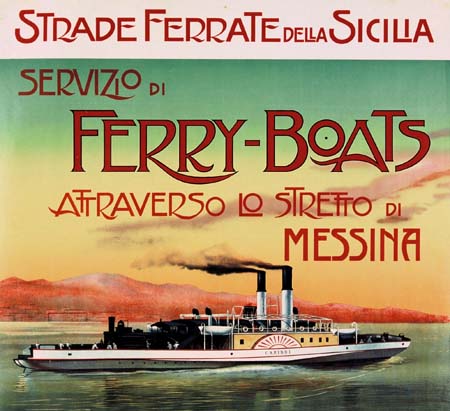 Train Ferry "Cariddi", poster of 1904 for the Treno di Lusso Napoli - Palermo (coll. Juergen Klein)
Train Ferry "Cariddi", poster of 1904 for the Treno di Lusso Napoli - Palermo (coll. Juergen Klein)
Start of Train Ferries
The steamer connection Reggio - Messina however worked rather unreliably. After long disputes, the railway Rete Sicula was authorized in 1893 to establish a ferry service between Reggio and Messina, 15 km distant. Already in 1881 naval architect Calabretto had made design proposals for paddle or screw-driven train ferries. Now a delegation traveled to Denmark in order to profit from the experience gathered there. Two 50 m long single-track side-wheel ferries with double-end-loading, named "Scilla" and "Cariddi" (Charybdis), were delivered from the Odero yard of Sestri in 1896, but it took another three years until being ready for freight operation.
In 1901 an express train from Rome to Syracuse was introduced. A coach and a van were to be transferred over the strait. From January 1903 additionally the new 'Berlin-Neapel-Express', one of the seasonal CIWL de-Luxe trains for millionaires and aristocrats willing to escape the winter, connected Sicily by providing a sleeping-car service Berlin - Palermo, combined with the 'Paris-Rome-Naples-Express', comprising a sleeper Paris - Palermo. South of Naples they were coupled to the 'Treno di Lusso Napoli-Palermo', advertised already in 1902, consisting of a CIWL day saloon car (ex Pullman), diner (a refurbished Pullman) and van, ferried from Reggio Port to Messina. An advertisement of 1904 under the label Strade Ferrate della Sicilia pointed out this de-Luxe and a connecting 'Treno di Lusso', surely similar, running from Messina to Giardini on the island. For ordinary passengers the ad listed also the possibility of crossing the strait via Villa San Giovanni and in 1905 a new ferry port was put up there. The train ferry route changed to Villa San Giovanni - Messina, shortening the passage from 15 to 8 km. The CIWL de-Luxe comprised from winter 1907/08 also sleepers from Paris and from Berlin to Giardini-Taormina and in winter 1913/14 a sleeper from the 'Wien-Rom-Express', the Vienna branch of the 'Berlin-Neapel-Express'.
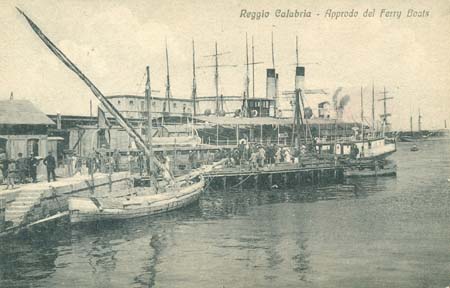
Reggio Porto in the first years of the 20th century (old card, coll. WS)
|
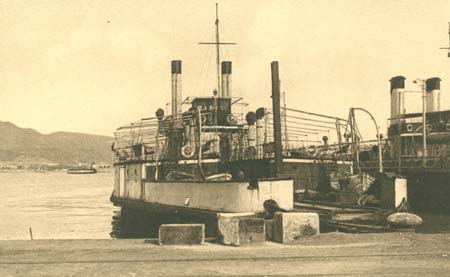
"Calabria" or "Sicilia", on the right "Reggio" or "Villa", at Messina (old card, coll. WS)
|
To reinforce the operation, two other ferries, "Calabria" and "Sicilia", were commissioned with Ancona and Palermo to enter service in 1905. A displacement of 653 tdw was reported. In the same year the railways of Italy have been united under the name Ferrovie dello Stato (FS) . To come up with the growing traffic, the administration commissioned two new train ferries. Before their delivery, Messina was struck by the dreadful earthquake of 1908 which destroyed nearly the entire town and killed 80,000 of her residents. Although the ferry ships were not seriously damaged, they had to stay out of operation for weeks. Instead, they were needed to transport supply goods for the afflicted town. Eventually in 1910 the new ferries "Villa" and "Reggio" (1,242 tdw) entered operation. They had screw-drive and carried either goods wagons or 4 express passenger cars on a single track.
Between the Wars
At the outbreak of the First World War the FS had 6 train ferries in operation, two of them with screw drive. "Calabria" and "Sicilia" were converted to gunboats for the navy. The latter sank by a mine in 1917. With the war the de-Luxe trains disappeared from Sicily for ever, but in the 20s, when exclusive CIWL sleeping-car trains were introduced in Italy, one was running from Rome to Syracuse and Palermo, ferried across the strait. The timetable e.g. of 1939 showed two ordinary expresses Rome -Sicily, comprising sleepers and coaches. The increasing volume of traffic demanded urgently for a new vessel. In 1922 the "Scilla", a sister ship of the "Reggio" and "Villa", joined the fleet. After modernization in 1931 the name was changed into "Aspromonte" (she shared the fate of the first "Scilla" in having been torpedoed opposite Cape Bon and sunk). To meet the positive economic development of Sicily, the first diesel-powered train ferry, the three-track "Messina" (1,242 tdw), was put in service in 1924. Reportedly she was unsuitable to take bogie passenger cars on board because of the tightly curved switches to the side tracks. She replaced the old "Cariddi", which was scrapped in 1923. Four years later, also the "Calabria" was taken out of operation. In 1932 came the third "Scilla" (4,406 tdw) and the second "Cariddi", two sisters being the first with diesel-electric drive. Their side tracks had a slighter curvature, so that the ships could take hold of 10 bogie cars, what meant a complete express train consist. Thanks to improved loading facilities at the terminals, 210,000 railway and 4,500 motor cars could cross the straits before the Second World War.
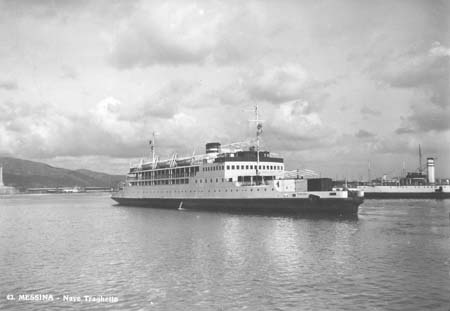
The second "Cariddi" at Messina before WWII (old card, coll. WS)
|
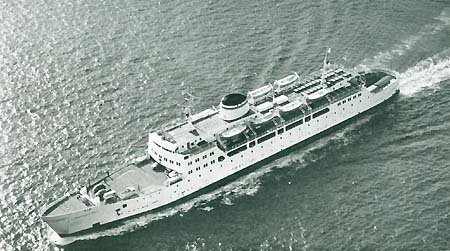
"S. Francesco di Paola" of 1964 (FS)
|
After World War II
The hostilities of WWII had a dramatic effect on the ferry fleet. All boats were sunk, apart from the "Messina", being in the dockyard during the invasion of the Allies. She resumed her service already in 1945. Yet the same year also "Villa", "Reggio" and "Scilla" were raised and repaired. It took however 3 other years to remove all the war-wrecks out of the port and to restore the regular ferry operation. Until that time the number of transferred railway cars had risen again to 283,000 and that of road vehicles to 12,500. The first newbuilds after the war were the "Secondo Apromonte" (2,708 tdw) and "Mongibello", entering service in 1948. The "Cariddi" was raised and when she left the yard of Genoa in 1953, she presented herself as a new ship, featuring 15.5 m more length, 4 tracks and a twin-screw drive with an increase in tonnage 3,123 and displacement to 4,805. Above the rail deck a second one for road vehicles was erected. This impressive two-funnel ship started operation in October 1953. Next to undergo modernization was the "Villa". Her old steam engine was replaced by a Fiat diesel engine. Then the "Messina" followed with slighter modifications. She got fitted with two new diesel engines and improved passenger facilities. Until the early 1960s, six train ferries served the passage over the Strait of Messina: "Villa", "Messina", "Scilla", "Secono Aspromonte", "Mongibello" and "Cariddi".
In 1960 a modern vessel joined the fleet: the "Reggio" (the second to bear this name) of 4,892 tdw. Loading was done through electrically operated front or rear gates. A single two-stroke diesel engine gave her a service speed of 15 knots and maneuvering was made easier by a front rudder. A slightly larger, but equally nice ship, the "S. Francesco di Paola" (5,160 tdw) was placed on the route in 1964, carrying 13 bogie cars, while the "Villa" and "Messina" were rebuilt into pure car-ferries. Also the larger "Iginia" (7,350 tdw) of 1969 represented the beautiful Italian style. She was followed in 1970 by the similar "Sibari" and in 1973 by the "Rosalia". At the end of the 70s the ABC Shipping Guide listed the "Rosalia", "Sibari", "Iginia", "Reggio", "Cariddi", "Secondo Aspromonte", "Mongibello", "Messina" and several car ferries. The "Reggio" and the "San Francesco di Paolo" were relocated to the route Civitavecchia - Golfo Aranci of Sardinia, like the other ferries there conveying only freight trains, until 2009.
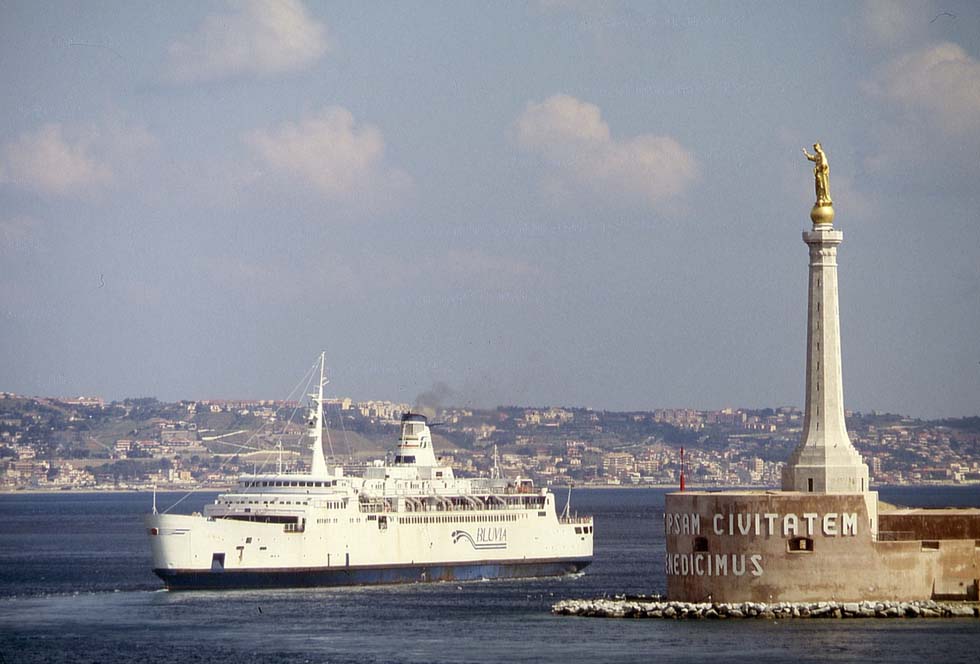
"Iginia" leaving Messina, 2009 (WS)
The passenger trains from Rome, ferried across the strait of Messina, continued service after WWII. From the 50s for the first time a 'Treno del Sole' connected Turin with Sicily, temporarily taking even a coach from Paris. From 1958 the "Freccia del Sud" linked Milan and Venice with Palermo and Syracuse, then Touropa tourist specials were listed between Dortmund/Hamburg and Taormina and towards 1970 a modern 1st-class electric railcar set Ale601 Rome-Palermo was introduced. Later mainly the sleeping- and couchette car expresses 'Treno del Sole' from Turin, 'Trinacria' from Milan and 'Frecia della Laguna' from Venice maintained long-distance connections with Sicily even in the 21st century, protected by the government from being competed by foreign low-cost airlines. Nevertheless some reduction started already and in 2011 the trains were confined to Rome - Sicily.
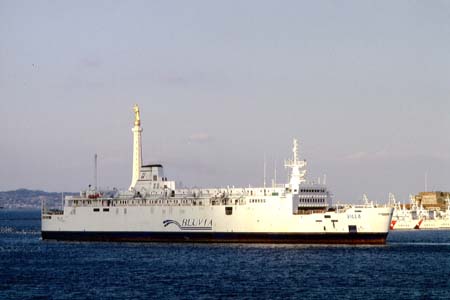
"Villa", arriving at Messina, 2009 (WS)
|
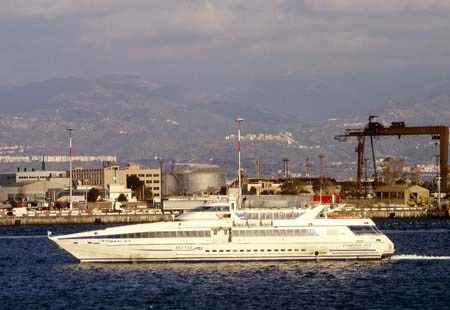
Hi-speed "Indari Jet" of Bluvia, leaving Messina, 2009 (WS)
|
Facing the traffic demand, two large ferries for 15 passenger cars each, the "Scilla" and the "Villa", had been introduced in 1985. With bow and stern loading, they are different from the "Iginia", which is using a front door only. Together with smaller car ferries, ShipPax listed for 2006 ten vessels, the biggest by passenger capacity being the "Rosalia", "Sibari", "Iginia", "Villa" and "Scilla", taking a total of c. 180,000 railway cars, 160,000 trucks and 370,000 motor cars from Villa San Giovanni to Messina, now operating under the label Bluvia. As mightiest competitor started in 1966 Caronte & Tourist with car ferries only. On the Reggio - Messina route, Bluvia matched by introducing hi-speed vessels for passengers.
Of course there were renewed ideas of a bridge. In 1986 the government examined the possibility of a rail and road bridge. Under Berlusconi the project came once again on the agenda, in 2010 halted. Until now, thanks to all the ferry services, Sicily has developed successfully into a busy island, as well agriculturally as industrially, with a large degree of autonomy.
For Sicily and other islands see also P.M. Kalla-Bishop: Mediterranean Island Railways, Newton Abbot 1970.
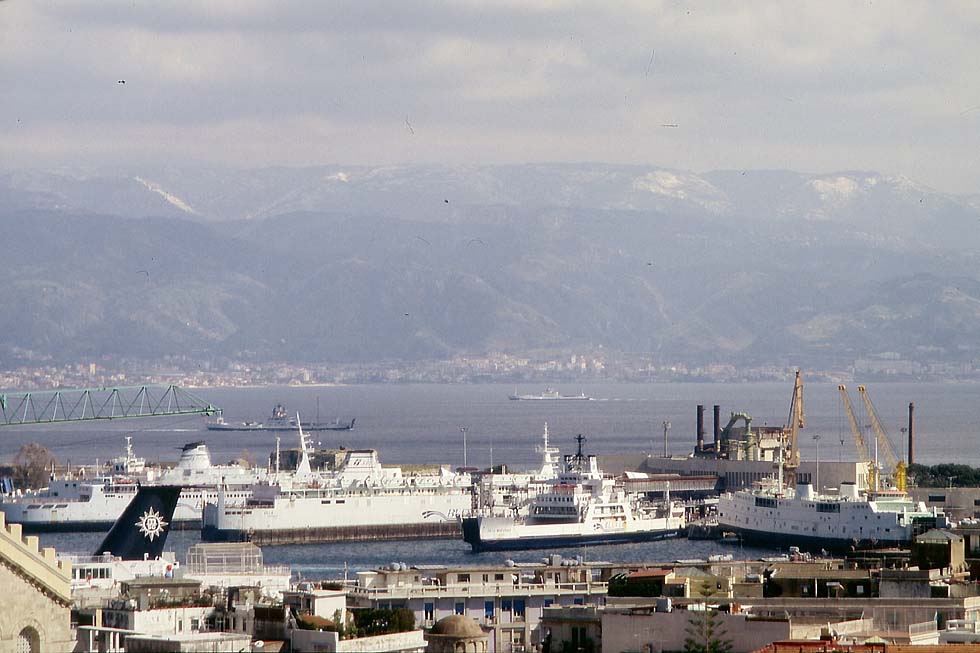
"Iginia" (?), "Villa" and car ferry "Fata Morgana" of Bluvia, Messina 2009 (WS)
|